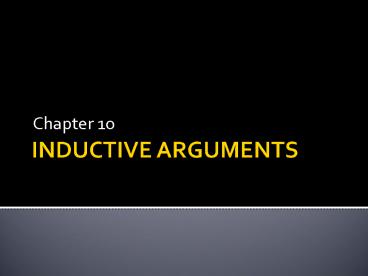INDUCTIVE ARGUMENTS - PowerPoint PPT Presentation
1 / 19
Title: INDUCTIVE ARGUMENTS
1
INDUCTIVE ARGUMENTS
- Chapter 10
2
Inductive Arguments
- Recall that inductive arguments are meant to show
that, given the premises, the conclusion is
probable. - Remember also, that inductive arguments aim for
strength, not validity. The latter implies that
the truth of the premises guarantees the truth of
the conclusion - There are two primary types of inductive
arguments - Analogical Arguments
- Inductive Generalization
3
Analogical Arguments
- In analogical arguments, the arguer generally
draws a conclusion about a single thing by
comparing to another, similar thing. - Example My friends 2006 Dodge Stratus
overheats. Im considering buying one, but Im
thinking that perhaps I shouldnt since it might
also have an overheating problem.
4
Analogical Arguments - Vocabulary
- The items being compared are called the terms of
analogy. (Ex. the two cars) - The term of analogy about which we draw the
conclusion is the target. (Ex. the car that the
arguer considers purchasing) - The property (or feature) in question is the
property attributed to the target in the
conclusion of the argument. (Ex. overheating)
5
Analogical Arguments Contd
- The general principle on which analogical
arguments are based is - The more similar the terms of the analogy, the
higher the probability that the conclusion is
true. - So, in the previous example, the arguer could
increase the strength of the argument, if the two
Dodges were from the same factory, if they would
both be driven by people with similar driving
habits, etc
6
Inductive Generalizations
- Inductive Generalizations
- always have a class of things as a target
- argues from a sample of the targeted class to the
targeted class as a whole - Ex. All six peaches that I bought from my local
grocer were mushy, so all the peaches in the
grocers batch are probably mushy.
7
Inductive Generalizations- Vocabulary
- Note that in the previous example, the peaches
that the arguer bought from the store constitute
the sample. - The peaches in the grocers batch constitute the
targeted class. - The property in question is mushiness.
8
Inductive Generalizations Contd
- The general principle for inductive
generalizations is - The more representative the sample of an
inductive generalization is of the target, the
stronger the argument. - The sample is representative in so far as it is
similar to the target class in all relevant
respects.
9
Biased Samples
- In the previous example, if all of the arguers
peaches were picked from the bottom of the fruit
bin, then the purchased peaches would constitute
a biased sample. - A biased sample is significantly different from
the target class in one or more relevant
respects. - Arguing from a biased sample weakens the
argument.
10
Representative Samples
- In order to obtain representative samples, we
should use randomly selected samples, of
sufficient size. - A random selection process gives every member of
the target class an equal chance of becoming a
member of the sample. - For formal inductive arguments, a standard sample
size between 1,000 and 1,500 is generally
considered a reasonable sample size.
11
Inductive Generalizations contd
- A confidence level measures the arguments
strength. A high confidence level indicates a
highly probable conclusion. - Our confidence increases
- as the size of the sample increases,
- as the error margin increases,
- An error margin is a range of percentage points
within which a conclusion is claimed to fall.
Wide error margins make for weaker arguments. - Note With the same confidence level, a
generalization from a larger sample will have a
smaller or narrower error margin making the
argument stronger.
12
Fallacious Inductive Reasoning
- Two examples of fallacious inductive reasoning
are - Hasty Generalization
- Generalizing from a sample that is too small.
- Ex. Both Harvard students Ive met have been very
rich. Harvard must only take rich kids. - Biased Generalizing
- Generalizing from a non-representative sample.
- Ex. I surveyed 2,000 students from New York
Citys St. Thomas Catholic School. 95 said they
never abused drugs. So we can safely conclude
that New York doesnt really have a teenage drug
abuse problem.
13
Class Exercises
- The last three cameras I bought from Roy were
total junk. Its probably the case that all Roys
cameras are junk. - 1) Name the target class and the sample.
- 2) Name the property in question.
- 3) If all the cameras that the arguer purchased
from Roy happened to be Sony brand, would that
strengthen or weaken his argument?
14
Class Exercises Contd
- An organization randomly selected and polled
3,000 Los Angeles residents on their abortion
views, and from those results, the organization
concluded that 75 of Californians 3 are
pro-choice. - 4) Is the sample size sufficient?
- 5) What is the margin of error?
- 6)What is the target class?
- 7) Whats wrong with the conclusion?
15
Review of Tuesdays Lesson
- Negation Claim Truth-Table
- P P
- T F
- F T
16
Review of Tuesdays Lesson contd
- Conjunction Truth-Table
- P Q PQ
- T T T
- T F F
- F T F
- F F F
17
Review of Tuesdays Lesson contd
- Disjunction Truth-Table
- P Q PvQ
- T T T
- T F T
- F T T
- F F F
18
Review of Tuesdays Lesson contd
- Conditional Truth-Table
- P Q P?Q
- T T T
- T F F
- F T T
- F F T
19
Review Contd
- Remember, to determine an arguments validity,
construct a truth-table with the claim variables,
the premises, and the conclusion. If you can find
any row in which all the premises are true but
the conclusion is false, then the argument is
invalid!































